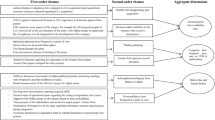Abstract
This article introduces the meso-unit theory of post-merger integration. The theory offers that the number of constituent work-units involved in an organizational merger has a greater detrimental effect on the time-to-integration than does the total number of constituent personnel involved. Its establishment is based on the results of controlled experiments conducted in a virtual laboratory. The simulation utilizes agent-based modeling software that encapsulates organizational behavior models such as the knowledge-based view of the firm, social and communication network theory, and CONSTRUCT theory. The software is configured for a two-organization merger and implements classic behavior dynamics to simulate communicative behavior of information-seeking actors. As a result, detailed micro- and macro-level data on the integration progress is available for examination, analysis and interpretation. The results give rise to the development of the meso-unit theory, which directs integration managers’ attention toward a key aspect of the integration that is often overlooked.







Similar content being viewed by others
Explore related subjects
Discover the latest articles and news from researchers in related subjects, suggested using machine learning.References
Allen P, Ramlogan R, Randles S (2002) Complex systems and the merger process. Technol Anal Strateg Manag 14(3):315–329
Axelrod R (1986) An evolutionary approach to norms. Am Polit Sci Rev 80(4):1095–1111
Backström T, Döös M (2008) Relatonics as a key concept for networked organizations. In: Putnik GD, Cunha MM (eds) Encyclopedia of networked and virtual organizations, vol 3. Idea Group Inc, Hershey, pp 1367–1374
Blau PM (1970) A formal theory of differentiation in organizations. Am Sociol Rev 35(2):201–218
Blumer H (1969) Symbolic interactionism: perspective and method. Prentice-Hall, Englewood Cliffs
Bruner RF (2005) Deals from Hell: M&A lessons that rise above the ashes. Wiley, New York
Bryson J (2003) Managing HRM risk in a merger. Empl Relat 25(1):14–30
Capron L, Mitchell W (2013) Build, borrow, or buy: solving the growth dilemma. Harvard Business Press, Brighton
Carley KM (1986) Knowledge acquisition as a social phenomenon. Instr Sci 14:381–438
Carley KM (1990) Group stability: a socio-cognitive approach. In: Lawler E, Markovsky B, Ridgeway C, Walker H (eds) Advances in group processes: theory and research, vol 7. JAI Press, Greenwich, pp 1–44
Carley KM (2002) Smart agents and organizations of the future. In: Lievrouw LA, Livingstone S (eds) The handbook of new media social shaping and consequences of ICTS. Thousand Oaks, Sage, pp 206–220
Carley KM (2003) Dynamic network analysis. In: Breiger R, Carley KM, Pattison P (eds) Dynamic social network modeling and analysis: workshop summary and papers. National Research Council, Washington, DC, pp 133–145
Cyert RM, March JG (1992) A behavioral theory of the firm, 2nd edn. Blackwell, Oxford
Dooley KJ, Corman SR, McPhee RD, Kuhn T (2003) Modeling high-resolution broadband discourse in complex adaptive systems. Nonlinear Dyn Psychol Life Sci 7(1):61–85
Frantz TL, Carley K (2009) Computationally modeling the effect of organizational complexity on post-merger integration. Adv Mergers Acquis 8:79–101
Grant RM (1996) Toward a knowledge-based view of the firm. Strateg Manag J 17:109–122
Harrison J (2007) Why integration success eludes many buyers. Mergers Acquis J 42(3):18–21
Hviid M, Prendergast C (1993) Merger failure and merger profitability. J Ind Econ 41:371–386
Krackhardt D, Carley KM (1998) PCANS model of structure in organizations. In: Proceedings of the 1998 international symposium on command and control research and technology, June, Monterrey. Evidence Based Research, Vienna, pp. 113–119
Lauser B (2010) Post-merger integration and change processes from a complexity perspective. Baltic J Manag 5(1):6–27
Lin B-W, Hung S-C, Li P-C (2006) Mergers and acquisitions as a human resource strategy: evidence from US banking firms. Int J Manpow 27(2):126–142
March JG, Simon HA (1958) Organizations. Wiley, New York
Marks ML, Mirvis PH (2001) Making mergers and acquisitions work: strategic and psychological preparation. Acad Manag Exec 15(2):80–92
Mitleton-Kelly E, Mitleton E (2005) Co-evolutionary integration: a complexity perspective on mergers & acquisitions. LSE complexity research programme. http://www.psych.lse.ac.uk/complexity/Publications/icosspublications.html
Porter ME (1987) From competitive advantage to corporate strategy. Harv Bus Rev 65(3):43–59
Rice RE, Aydin C (1991) Attitudes toward new organizational technology: network proximity as a mechanism for social information processing. Adm Sci Q 2:219–244
Salancik GR, Pfeffer J (1978) A social information professing approach to job attitudes and task design. Adm Sci Q 23:224–253
Schweiger DM, DeNisi AS (1991) Communication with employees following a merger: a longitudinal field experiment. Acad Manag J 34(1):110–135
Simon HA (1957) Models of man: social and rational; mathematical essays on rational human behavior in a social setting. Wiley, New York
Stryker S (1980) Symbolic interactionism: a social structural version. Benjamin/Cummings Publishing, Menlo Park
Tsoukas H (1996) The firm as a distributed knowledge system: a constructionist approach. Strateg Manag J 17(S2):11–25
Wernerfelt B (1984) A resource-based view of the firm. Strateg Manag J 5:171–180
Author information
Authors and Affiliations
Corresponding author
Rights and permissions
About this article
Cite this article
Frantz, T.L. The meso-unit theory of post-merger integration. Comput Math Organ Theory 24, 99–111 (2018). https://doi.org/10.1007/s10588-017-9248-2
Published:
Issue Date:
DOI: https://doi.org/10.1007/s10588-017-9248-2




